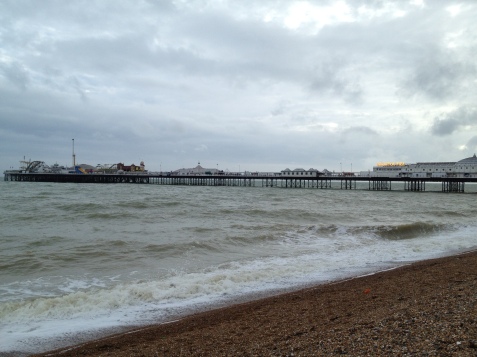This summer I was able to make a research in the Design Archives at the University of Brighton. After attending the conference on the 50s anniversary of the Design Research Society (see my report), I stayed longer in Brighton to visit the Design Archives.

Brighton pier and the sea
This institution is one of the most important, paper based archives for design history. It was founded in the 1990s and contains of about twenty different archives, which cover aspects of graphic, furniture and industrial design. Financed by the government and private foundations, the archive is collecting different types of documents related to design. And it is not a coincidence that Brighton keeps such a great institution. One hour far away from London at the channel, the University of Brighton is one of the leading institution in Great Britain within the field of the design histories.

Entrance to the Design Archives at the University of Brighton
As in every other archive, you have to ask for an appointment and as well for a permission, to see contemporary material. Via email or by phone it is easy to contact the very helpful staff of the archives. As a finding aid the archival items are listed in the online hub of UK archives. They store the description from about two hundred institutions in Britain, that keep historical documents. By this service it is quite easy to search and especially prepare your visit at an archive. I am asking myself why isn’t that possible for Germany or whole Europe?
Furthermore in the Design Archives it is allowed for users to take photographical notes from documents. This is not a reproduction, because you have to use your own camera and must cover the document with a plastic foliage with a good visible remark from the Design Archives. But anyway you have a picture of the document, so you can work on it at an later moment back at home. In my point of view it is a very good way to help the user and give security again right abuse for the archive. Again, why isn’t that possible in Germany?
My interest were the files in the ICSID archives, which came in 2007 from the University of Compiègne, where it was held on behalf of ICSID. In these papers I could see how the West German institutions – like the VDID, Rat für Formgebung or the IDZ Berlin – interacted with other industrial designers. And as a special German perspective it came clear to me that the ICSID was also an important battlefield in the Cold War. The delegates from East and West Germany i.e. at the conference 1975 in Moscow hand many discussion about the problems, how was allowed to come with which wording of the own state. Nevertheless this changed, and again Moscow was – in my point of view – the turning point. Because here it was the first time that industrial designer from East and West Germany came together. Keeping on this, I am arguing in my thesis that in the 1980s there was no iron curtain for some parts of the industrial designer at the inner German border anymore.
The Cold War is fortunately over, but parts of its memory are stored in the Design Archives. In Brighton, they do not only „store“ documents, they also conserve them. In an inspiring blog the staff is writing about their doings, so everybody can follow what a great job they do. Beside this a lot of thesis are written with sources from the Design Archives by many PhD students. The most important one for my research field is the project from Tania Messell about the history of the ICSID. I am really looking forward to that publication.
The Design Archives at the University of Brighton also work on different exhibitions, i.e. about the history of the Design Research Society, that was presented parallel to the DRS2016. And it would be totally wrong calling the Design Archives old fashioned. They are open for digital tools on the internet – not like so many archives or museums in Germany. For example the Design Archives make a lot of documents online accessible, as well as many pictures in the VADS database. Furthermore the staff of the archive use a Flickr-account to give their masterpieces a stage on open access. It is also less surprising that the Design Archives use social media like twitter @design_archives to communicate.

Sign to the Design Archives
To sum up: Visit to the Design Archives at the University of Brighton, for design historians it is really worth to go there!
